Product Requirements:
Device:
Palm PDAs with the Universal Connector
88k PRC
The first thing that I think of when someone mentions PDA keyboards is the
Stowaway Folding keyboard from
Think Outside. It has been my personal
favorite from the very beginning. I have one for almost all of my PDAs. But, like
many products, there are always little things that you wish were changed or
better. The biggest wish of Stowaway users has been the ability to type on your
lap. Unfortunately the folding keyboard did just that, folded while trying to
use it on a non-flat surface. Well, Palm PDA users can now rejoice in the fact
that Think Outside listened to their wishes and has addressed them in their new
model.
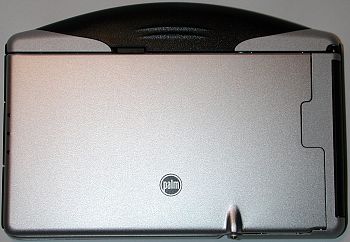
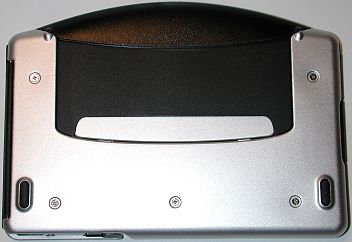
The Stowaway XT Ultra-Thin keyboard, which is currently only available for Palm
devices that have the Universal Connector, has just become available. Thinner
and lighter than their previous model, this keyboard looks great! But does it
perform as good as it looks? Let’s check it out.
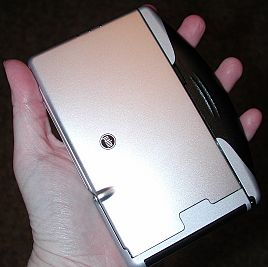

[Top to bottom: XT, original Stowaway]
The first thing I did was try to open it. This actually took me a few seconds
and I’m ashamed to say that I even had to look at the included instruction
sheet! The release button on the side blends in so well, that I didn’t see it.
Once I knew what I was looking for though, the keyboard popped open
effortlessly. It is actually easy enough to open and close with one hand.

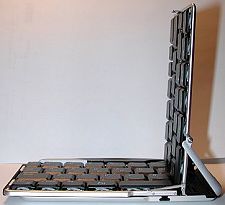
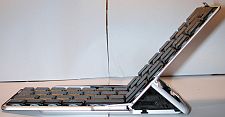
The keyboard opens left to right as if opening a book’s back cover. As you
lift the top section, the bottom section slides to the left. As you pivot the
top section 180 degrees, it snaps flat in place. When the keyboard is fully
opened, it can be used on almost any surface including your lap. It feels quite
rigid and secure. A small button with near the letter
P is the release button when you want
to close the keyboard.
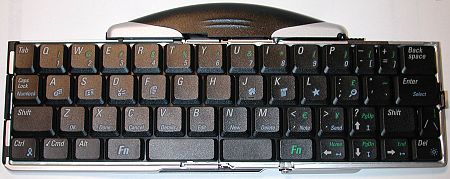
To connect the PDA, you pull out the connector / stand which pops up ready
for you to connect the PDA. I didn’t have any problems connecting my
Tungsten T to the XT keyboard even
using one hand.
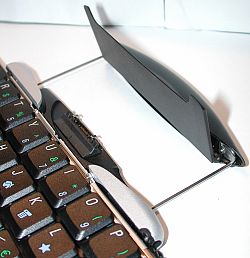
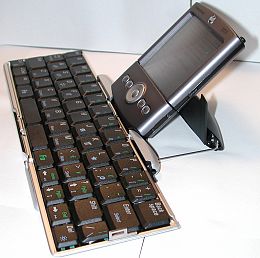
Before you can actually use the keyboard you must first install the driver. This is
a 88k PRC file that allows you to manually enable and disable the keyboard as
well as changing the repeat rate, delay until repeat rate and audible key
clicks. You also have the option to change the keyboard layout from English to
English (Dvorak), German and Japanese.
The driver will not interfere with syncing the PDA to your desktop. You can’t
however use the IR port while the PDA is attached to the keyboard.
People were always commenting about the older version, that it might not be
very robust due to the folding design. I think this new design feels much
stronger and I don’t have a worry that it is going to wear out from opening and
closing. Like the original, this version also has a metal outer shell. I do
think that the original version is more tank-like when closed though. The XT has some
thinner plastic parts in the connector / stand area and spine area that do flex
and bend. It is important to keep the keyboard in it’s protective zippered slip
case when not in use. I wouldn’t want to just throw it in the bottom of a gear
bag for fear that an object might jam itself into the connector / stand assembly
by accident.
I never had a complaint about the size of the original Stowaway, so when I
first got my hands on the XT, I was pretty much floored at the small size. WOW,
is it thin! Comparing it to the original version:
| XT Ultra-Thin Keyboard | Original Stowaway Folding Keyboard |
|
| Size | Closed 5.5 x 3.9 x .5 in (139 x 99 x 13 mm) Opened 9.9 x 5.8 x .5 in (251 x 148 x 13 mm) |
Closed 3.6 x 5.1 x 0.8 in (93 x 130 x 20 mm) Open 13.8 x 5.1 x 0.44 in (352 x 130 x 11 mm) |
| Weight | 5.6 ounces (160 grams) | 7.9 ounces (224 grams) |
Maybe the smaller size of this keyboard worries you..? I know that as a touch
typist, it did me. When I opened the XT and saw how small it was, I was
concerned if touch typing would still feel a comfortable as it was on the
original version. Guess what? You’ll be happy to know that the keys are the same
size. At 18mm, the space between the keys is only 1mm narrower than the original
version. Key travel is the same at 3mm.
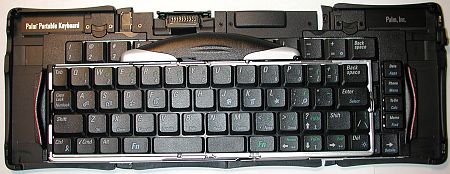
[XT on top of the original Stowaway]
Since the keys are the same size, how the heck did they shrink the overall
size so much? Well, they did it by removing the entire top row of number /
punctuation keys and the separate application launcher keys. To access them, you
have to use a function key combo. This is probably my only gripe about this
keyboard. It’s not a super big deal, but it does slow you down when you need to
type a number or a punctuation character as you have to consciously seek out the
function key and associated button. Luckily, the most popular punctuation
characters still have their own keys… such as the
. , / – ? keys. International
characters are supported using a combination of CTRL, ALT key presses. Good luck
memorizing the combinations if you need to use these type of characters often.
It would be nice to have a popup window that you could scroll thru and select
the character needed.
I spent a couple days typing to get a feel of just how easy it is to go from
a regular PC desktop style keyboard to the small XT Ultra-Thin. Like the
original Stowaway, this one is comfortable and easy to touch type with. The
Enter key, Backspace, Spacebar, and Shift keys are all located exactly where my
fingers thought they should be located. So, there wasn’t a learning curve. About
the only keys that I did have problems with were the
!, @ and
/ keys as they required function key combo presses.
I also found that I still needed my stylus close by. This keyboard does not
allow you to be totally stylus free unfortunately. The onscreen pointer feature
is not yet available for OS 5.
I have tried quite a few different PDA keyboards in the past few years, but I
still pick the keyboards from Think Outside as the ones that put in my gear bag
every day. They know what they are doing and keep doing it. If you touch type,
don’t look any farther then the XT.
Price: $99.00
Pros:
Small, compact size
Comfortable full-sized keys
Can use on almost any surface
Cons:
Number and punctuation keys require function key combo press to
activate
International characters require combo key presses
Still need a stylus to select items
Gerber Gear Suspension 12-in-1 EDC Multi-Plier Multitool with Pocket Knife, Needle Nose Pliers, Wire Cutters and More, Gifts for Men, Camping and Survival, Grey
23% OffGerber Gear Diesel Multitool Needle Nose Pliers Set, 12-in-1 EDC Multi-Tool Knife, Survival Gear and Equipment, Black
$129.99 (as of November 30, 2025 18:08 GMT -05:00 - More infoProduct prices and availability are accurate as of the date/time indicated and are subject to change. Any price and availability information displayed on [relevant Amazon Site(s), as applicable] at the time of purchase will apply to the purchase of this product.)Product Information
| Price: | 99.0 |
| Manufacturer: | Think Outside |
| Pros: |
|
| Cons: |
|




Gadgeteer Comment Policy - Please read before commenting
I only view DivX files on my PDA. This is so I can view the files on both platform (PalmOS and PocketPC). For PocketPC its PocketMVP which is quite a mature program and for PalmOS I use MMPlayer – not very stable but works well if you reserve a large memory for it to use for packet audio/video storage and overclock it to 600Mhz.
I recently dumped my h2210 in favour for the T3 (for the higher resolution) so I have been re-encoding my movies in 480×320 format. My current 320×240 files can still be viewed on the T3 though and MMPlayer allows me to ‘zoom’ them to full screen. Viewing films on the T3 is very enjoyable and I can fit 5 Futurama episodes (22 minutes each) on my 256Mb card. Of course since Futurama is an animation the bitrate can be set to 33kbps and quality won’t be affected (since animation is less complex than life action films) and 22kbps mono audio. Frames is at 12.5fps (normal for animations). Overclocking is not needed here.
However increasing the bitrate does not affect performance on my T3 and I am happy with my widescreen Kill Bill trailer (90kbps video, 32kbps audio bitrate, 12.5fps). I won’t consider using any other video format such as WMV because of the cross platform issues. For high bitrates and 25fps videos overclocking is needed (as on my PocketPC).
I had tried MMplayer, but the mpeg I tried with it played at about 1 FPS! Any software that can’t run properly at 400Mhz is still a work in progress, which I know MMplayer is. The app has huge potential, and I wish them the best.
Kinoma works well enough but the codec needs to be updated, as does the smothing and dithering methods during playback. Frame rate has never been an issue, and the new stereo sound is good. I have the pod race from Phantom Menace, and there is NO mistaking the stereo imaging… huge improvement, but I wish they had EQ on the producer, and a lot of internet clips have less than balanced sound. You really need the full producer to mess with the video bitrates and size. Something that messed me up with earlier versions (before the video even got to Kinoma) was that my desktop software used for capture did a poor job of rendering. Upgraded to Pinacle Systems which is a thousand times better, and resulted in better quality on the Palm of course. The limitation I see now is that I cannot render on my laptop at 320×480, so Kinoma tries to spread out the available pixels to fill the space which makes it look more pixelated. Spreadsheets and databases are more important, so I’ll be sticking with Palm, but I think PPC does better at smoothing with existing software.
I use a program called EazyVCD to rip DVD’s I honestly and truly own, to my hard drive. The program automatically converts the RAW DVD to MPEG-1.
I then use Windows Media Encoder to convert the files to WMV’s that I can watch on my Pocket PC. The process takes about 18 hours per DVD disc to rip, convert to MPEG-1 and then convert to WMV.
And yes, I am only doing this with DVD’s that I have purchased, for my own, personal use. Please don’t ask me to make copies available. I won’t do it.
Respectfully,
Christophe rSpera
I’ve been using Kinoma to watch TV shows on my Treo 600. It’s the first OS5 Palm I’ve owned and I’m really happy with the video and audio (audio is great!). I usually convert to 12 frames per second to save space on my SD card so an entire episode of Seinfeld runs me around 28 mb. Only problem is that you have to own Kinoma Producer and it took me a couple tries to get the settings right for converting to 160×160 (yeah everybody complains about that resolution, but I have never owned anything higher and don’t know what I’m missing)
I personally do not care for Kinoma… mainly because it does not play regular old MPEG-1 files. I’m basically lazy, and just want to download stuff and not have to mess with conversions. That’s why I like Windows Media Player.
Does Pocket TV or Pocket MVP play .AVIs or other video formats?
I also enjoy Flash animations… Have you guys seen the cartoons at http://www.macboy.com ? They are the BEST! 😀
18 HOURS? Wow, I guess I shouldn’t complain about those 2 hour jobs in Studio Version 8 and Kinoma.
Don’t worry about asking for copies from me, I can rip from DVD, VHS and camcorder, so I’ve no shortage of material and would not ask even if I did need material.
PocketTV plays AVIs, but I forget which other formats are supported. I had a problem with earlier versions that caused the device to remain on, but I assume they fixed that a while ago. I’ll check out the cartoons… thanks for the link!
PS: The new version of Kinoma is loads easier; you can grab every video on your desktop and click go. It also supports multiple concurrent processing, so it can actually convert multiple movies at the same time. Still not the same as drag and drop, but relatively painless.
Altema, which MMPlayer version are you using? 1fps is very slow. Wait you are talking about Mpeg! Sorry… I don’t run native Mpeg on MMPlayer so I don’t know the performance.
I don’t use Kinoma due to the fact that it uses old legacy codec. In order to get it to the same level as DivX, the files would need to be 3-4x the size! And still the quality isn’t as good.
Chris, 18 hours is truely long to convert. I use DVDDecrypter to ripped DVDs (also legally owned) and use XMpeg to decode it to DivX. 4 hours for that. Use VirtuabDub to resize the resolution, edit out unwanted parts (end credits), lower the audio bitrate and rotating the film. Another 8 hours wasted. It isn’t so bad, I usually only do it when I am a sleep (although my PC is noisy!).
Jullie, Pocket MVP does play most formats including Avi, DivX, OpenDivX and Mpeg-1.